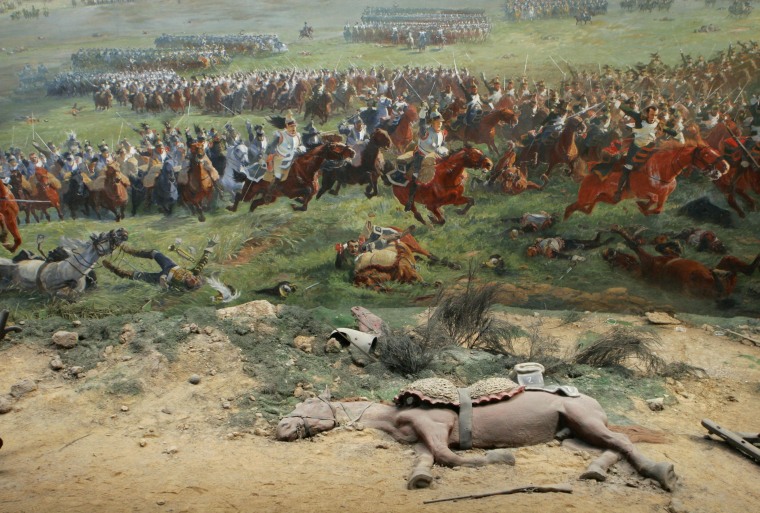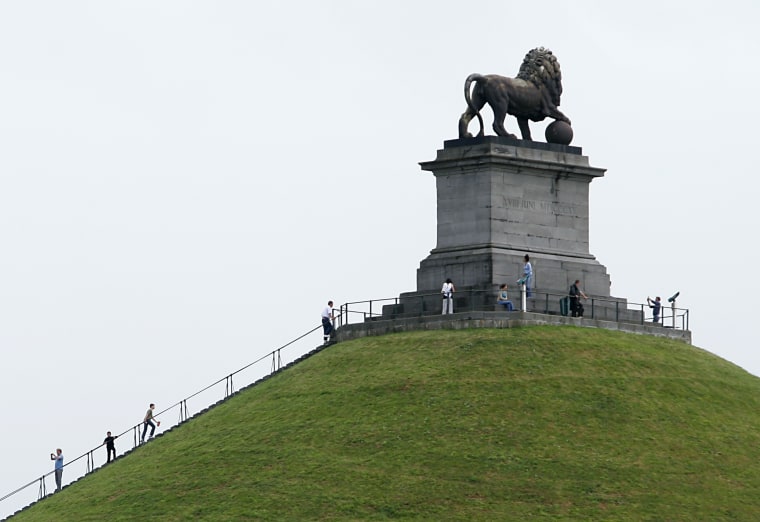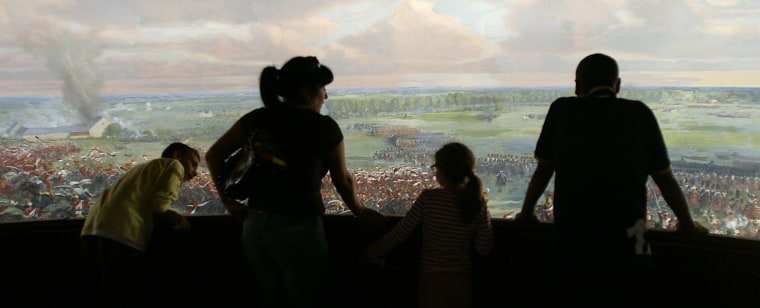It's hard to believe anyone would choose the crackle of distant cannon fire and a very dated 360-degree wall painting over in-your-face kinetic effects of movies and theme parks.
But annually more than 200,000 people visit the Waterloo Panorama for the thrill of seeing a vast, dilapidated, century-old painting showing Napoleon's last stand.
Carole Fonteneau of St. Malo, France, emerged from the place recently fairly excited.
"It's quite real with sounds," she said. "My little boy is impressed, too. But it's still hard to feel how it was to be in such a battle."
A visit to Waterloo, where Napoleon was decisively defeated by the Duke of Wellington in June 1815, is a march back in time in more than one way.
Its panorama shows not only Napoleon's final adieu but, in the era of the Internet, IMAX movies and Wii, is an enduring and endearing icon of old-fashioned art and entertainment.
Panorama insiders and painters — yes, they still paint those things! — say the vast circular canvases offer a rare, unrushed experience that beats the helter-skelter of multimedia entertainment.
"The timing of all those games is hectic. I think people have a longing for non-hectic things, too," says Ernst Storm, president of the nonprofit International Panorama Council.
With panoramas, he adds, "you have the time to absorb the experience and to immerse in it on your own timetable."
Sanford Wurmfeld, an art professor at New York City's Hunter College has painted two abstract panoramas — Cyclorama 2000 and E-Cyclorama — which have been displayed in both Europe and the United States.
He says it is the absence of the digital sound and fury that makes wall paintings so enjoyable. Visitors do hear muffled cannon and gunfire in the background at the Waterloo panorama, but it's very low-tech compared to what you could experience on any home computer today.
"It is exactly in contrast to the Internet, video, and other 'hot media' that I think my panoramas take on their greatest function," he said in an e-mail to The Associated Press.
"The new media tends to encourage passive viewing. I see painting as the ultimate example of the static medium which requires the most active participation by the viewer to experience it fully."

The panorama of the Battle of Waterloo is 330 feet long and 36 feet high. It was inaugurated in 1912. Since then the years have left a mark.
Leaking rainwater mars the soaring canvas in several places. The dimmed light cannot hide the dust covering life-sized soldiers and horses on the artificial terrain that blends into the painting.
Visitors to the area can also tour the actual battlefield, several museums and other attractions, including the Butte du Lion, or Lion Mound, an artificial hill with a view of the battlefield that was built as a monument to mark the spot where the Netherlands' Prince of Orange was wounded during the fight.
Traveling panoramas were popular across Europe in the 19th century, showing country folk exotic scenes of distant cities, landscapes and historical events.

The International Panorama Council believes 120 or so survive worldwide in various sizes and conditions — half of them in Europe, 40 in Asia, about 10 in North America. A popular panorama in the U.S. is the Gettysburg Cyclorama in Pennsylvania, depicting the Battle of Gettysburg, a turning point in the Civil War.
Cairo has Africa's only one. It shows the "Panorama of the Epic of 6th October 1973" that set off — depending on your Mideast bias — the Fourth Arab-Israeli War, the Yom Kippur War, the Ramadan War or the October War.
Scott Wilcox, a curator at the Yale Center for British Art, estimates "hundreds and hundreds, if not thousands" of traveling panoramas were painted in the 150 years after Irish painter Robert Barker invented them in 1792.
Barker coined the word panorama from Greek: 'pan' meaning everything and 'horama' meaning view.
"I must admit, some 15-20 years ago when virtual reality started, we thought the popularity of panoramas would diminish. But that is not the case," Storm, the panorama council chief, said in a telephone interview.
Wilcox, who wrote his master's thesis on panoramas in 1976, speaks of a "new burst of popularity."
He credits panoramas' ability to create a unique illusion and a public nostalgia for the survival of the large-scale art form.
More than 20 panoramas have been painted in the last decade, including two abstract ones by Wurmfeld.
"I find this the most satisfying form of painting in which I am now involved," he said. He plans to paint at least two more if he can find venues interested in exhibiting them.
Wurmfeld's inspiration comes from the mother of all panoramas: the Panorama Mesdag in The Hague, Netherlands.
It is Europe's biggest panorama, showing an 1881 Dutch dunes-and-beach scene on a curved space of 377 by 49 feet. The work of Dutch painter Hendrik Willem Mesdag, it receives 130,000 visitors a year.
